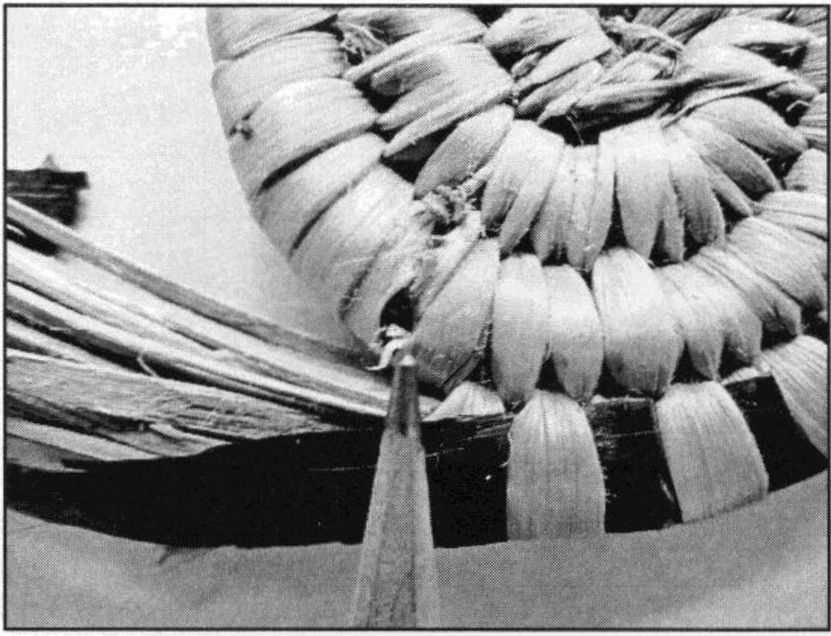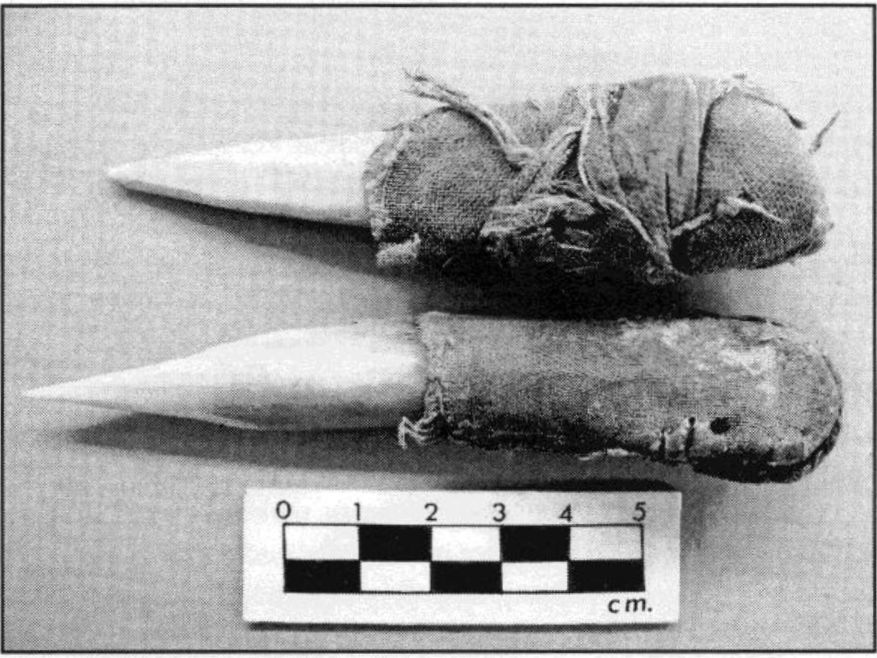Originally published in The Midden, 44(1), 10-12.
2012.
By Grant Keddie

We can all applaud the fact that some archaeologists are asking more theoretical questions, having moved beyond basic artifact description. However, it is clear that research undertaken to espouse new ideas often depends on poorly classified assemblages.
Our knowledge of the timing and distribution of even some of the most common artifacts remains uncertain. The precise use of many of the artifacts that are found is often unknown, and sometimes, mistakenly, a correlation is assumed between archaeological and ethnographic artifacts.
In order to judge the accuracy of ethnographic information, archaeologists need to be aware of the process of how ethnographic information builds upon and interacts with the ethnographic and historic records. Museum catalogue records are part of this process.
Few archaeologists have had the opportunity to work with ethnological collections, making it difficult to recognize a need for and thus develop a critique of the world of ethnographic artifacts. Instead, statements are often made assuming an obvious relationship between archaeological assemblages of a certain age and what is perceived as the ethnographic correlates without quantifying what exactly is equivalent.
To help bridge a discussion on the nature of the relationship between archaeological and ethnographic artifacts, 1 examine a range of ethnographic artifacts—mostly those of bone and antler— that have archaeological correlates. Sometimes, the correlation is clear and, at other times, it is a bit fuzzy. In this article, I will focus on metapodial bone awls.
Ethnographic Evidence
In comparing the ethnographic record to the archaeological, it is important to understand the nature of the specific ethnographic collections. When, where and from whom was the artifact collected? Who is the source of the information and what was their background? Is the item actually a traditional ethnographic artifact that was used, or was it an item made for sale or made as a model for a collector or anthropologist? It is not uncommon to find that bone items in ethnographic collections actually came from shell middens and were assigned an assumed function.
Metapodial Bone Awls
In the Royal British Columbia Museum ethnographic collection, there are 16 bone artifacts called “awls” from southern British Columbia that appear to have actually be used as awls. They are all deer lower leg metapodial bones. There are no ulna bone tools of a traditional ethnographic nature described as awls in the collection—only one (17681) that is from a shellmidden, and one (14537) that is a modem artistic example that represents an awl “used for punching holes in leather.”
All of the metapodial awls were collected after 1906, and 75% of them were collected after 1965; there are no 19,h century examples. Eight awls were collected in 1965, four in the 1967 to 1969 period, one in 1946 and three in the 1906 to 1913 time period.
Eight of the nine Interior examples were collected in 1965 by Robert Nichols, who was hired by the Museum to visit various Interior First Nations reserves to purchase artifacts for the Museum. Nichols had no formal training in ethnology.
One group of three awls was collected in 1965 from a male individual on the Lytton Reserve. These have cloth wrappings around the proximal ends, which would be for protection of the hands during long periods of use. Artifacts 12092a (L. 224mm, tip missing) and 12092c (L. 141 mm) are half sections and 12092b (L. 173mm) a quarter section of metapodials. The catalogue information from Nichols noted “For making baskets. Hind leg of deer” (Figure 1).
Another group of two awls was “purchased from the maker,” a woman on the Lytton Reserve. The catalogue records awls 17503 (L. 190mm) and 17504 (L. 217mm) as “Sku-walth (Awl) from the hind leg of deer. For making holes in basket (top)” (Figure 1). The latter awls were purchased with basketry making materials that included a bundle of split cedar roots and dried cedar roots used “for coiled Basketry.” It may be safely assumed in this case that the awls were used in making coiled baskets. Since the making of coiled baskets requires the punching of a hole through strips of the raw material with a sharp point, these awls fit the function.

Figure 2 shows the 2mm hole that needs to be pushed through the middle of the stiches on the inside coil, in order to pull through a splint from the next coil.
Three awls—12106a (L. 220mm), 12106b (L. 200mm) and 12106c (L. 124mm, tip missing)—were purchased from a person on the Fairmont Reserve in the Kootenays and catalogued as “For making baskets. Deer bone” (Figure 1).
The ninth Interior example of an awl, 6374 (L. 182), was purchased from a woman on the Creekside Reserve near Lillooet in 1946, and is referred to as a “Basket Makers needle,” although technically it is not a needle (Figure 3).

Two other awls purchased by Museum personnel in 1967—12830(L. 83mm) and 12831 (L. 251mm)—are catalogued as “Salish unspecified” (Figure 1). In addition to the statement that they are bone awls used in basket making, is the comment: “use not recorded when purchased.” This indicates to me that they are being catalogued as basket-making awls on the basis of a similarity to other known basket-making awls.
The five awls from the region of Coast Salish Speakers include two with their extreme tips missing— 13089 (on exhibit, not available for image or measurements) and 13090 (L. 226mm) —that were “purchased from and used by” a woman in Yale and described as “basket bone awl” (Figure 1, 13090 only).
Awl number 10876 (L. 186mm) was from the collection of Charles and William Newcombe, but originally part of the collection of Emily Carr (Figure 4). Carr obtained it in North Vancouver from her First Nation acquaintance, Sophie Frank, most likely while she lived there between 1906 and 1913.

Two awls—2448 (L. 99mm, tip missing) from the “Lower Fraser River” area, collected about 1911-1913, and 9853 (L. 113, extreme tip missing)—both have sewn pieces of European- manufactured cloth around their proximal ends (Figure 5).

Artifact 9853 was collected in 1911 from the general area of Chilliwack. It is listed as “Awl—bone, basket makers.” Artifact 2448 is listed as a “mat maker’s” awl. Given the lack of specific provenience on the artifacts, I would suggest that the cataloger may have been guessing at their function.
It is not certain if the description “mat maker’s awl” was intended to refer to cedar mats or tule reed mats. Cedar mats do not require the poking of a hole during their manufacture. In the making of tule reed mats, a long needle is pushed through the reeds; a smaller awl is not required. However, in the 20th century, some women used a steel awl to push the fibres together when making tule mats.
Discussion
Coiled baskets are believed to have been introduced to the southern coast in historic times (Barnet 1955:124; Drucker 1950:193, 266). Since non-coiled baskets do not require the punching of a hole, we might surmise that sharp pointed bone tools found in archaeological sites on the southern coast were not used for making basketry. One exception to the rule may be the creation of holes to attach leather straps to finished baskets.
Late 18th century historic accounts note the extensive wearing of animal skin clothing. This fact, in combination with the extensive occurrence of deer and elk remains in archaeological sites, may suggest that sharp, pointed, awl-like tools were most likely used for the preparation of animal skins and the making of clothing and other items involving the use of skins.
One must keep in mind that the bone awls presented here are a product of women making and selling baskets mostly for a modern market economy. When developing typologies of bone tools, we also need to keep in mind that all of these ethnological bones tools were made using files and other iron or steel tools.
One effect this may have had on the shape of tools is more pronounced shouldering below the thin point due to the fact that an iron tool can grind off bone material far easier than traditional tools.
Conclusion
In looking at the potential function of archaeological artifacts, and doing so by drawing comparative correlations between the records of archaeology and ethnology, we need to be aware of the sometimes sketchy nature of the ethnographic record. In the case of bone awls, being able to make a distinction between the potential function of sharp pointed, as opposed to duller pointed, bone tools may be of use in our effort to determine past human behavior in specific regions or time periods.
References Cited
Barnett. Homer. 1955. The Coast Salish Of British Columbia. University of Oregon. The University Press, Eugene, Oregon.
Drucker, Philip. 1950. Cultural Element Distributions: XXVI. Northwest Coast. Anthropological Records 9:3. University of California Press. Berkeley and Los Angeles.